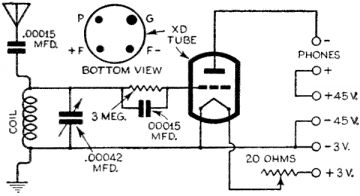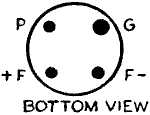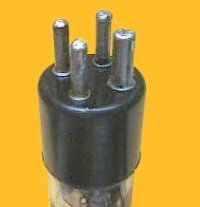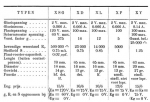
XD
|
|
||||||||||||||||||||||||||||||||||||
|
Hits: 2494 Replies: 0
XD: Pocket radio built into a notebook
|
|||
|
Georg Richter
14.May.10 |
1
Since there is not yet any model listed which is equiped with the XD tube, here we are with a project issued earlier by "Popular Science Monthly" and later in the book "Radio For The Millions", extracted from page 189 of the 3rd print of 1946: Pocket Radio Built Into A Notebook
Built into a 3" by 4" loose-leaf notebook, this tiny one-tube, earphone radio can be carried easily in your coat pocket. Its single tube, a midget triode measuring less than 3", requires but 3 volts for its filament and 45 volts for its plate. Because of limited space, no socket is used, connections being soldered directly to the pins at the base, and the tube is sewed to the front cover to hold it in place. A small .00042-mfd. insulation-spaced variable condenser tunes the set. It measures ¼" square, and has a depth behind the cover of only 3/8". The tuning coil is a high-impedance primary coil of the type used to replace burned-out primary windings in standard A.C.-D.C. receivers. However, you must unwind approximately 100 turns to make the coil suitable for receiving stations between 200 and 550 meters. Current is supplied by the new midget "A" and "B" batteries, also small enough to fit in your coat pocket, and four small jacks provide connections for the antenna, ground, and phones.
LIST OF PARTS NEEDED: Midget tuning condenser, .00042 mfd., paper-spaced instead of air-spaced. High-impedance primary coil. Two mica condensers, .00015 mfd. each. Resistor, 3 meg., ½ watt. Midget detector tube (see text). Rheostat, 20 ohms. Midget 45-volt "B" battery. Midget 3-volt "A" battery. Battery cable, three-way, about 3' long. Four jacks and plugs. Five soldering lugs. Small black loose-leaf notebook. Earphones, dial, knob, etc. An easy project for a rainy day, so we wait for your results beeing demonstrated ... the color of the notebook doesn't matter. Best Regards, GR |
||
End of forum contributions about this tube
| Data Compliance | More Information |







